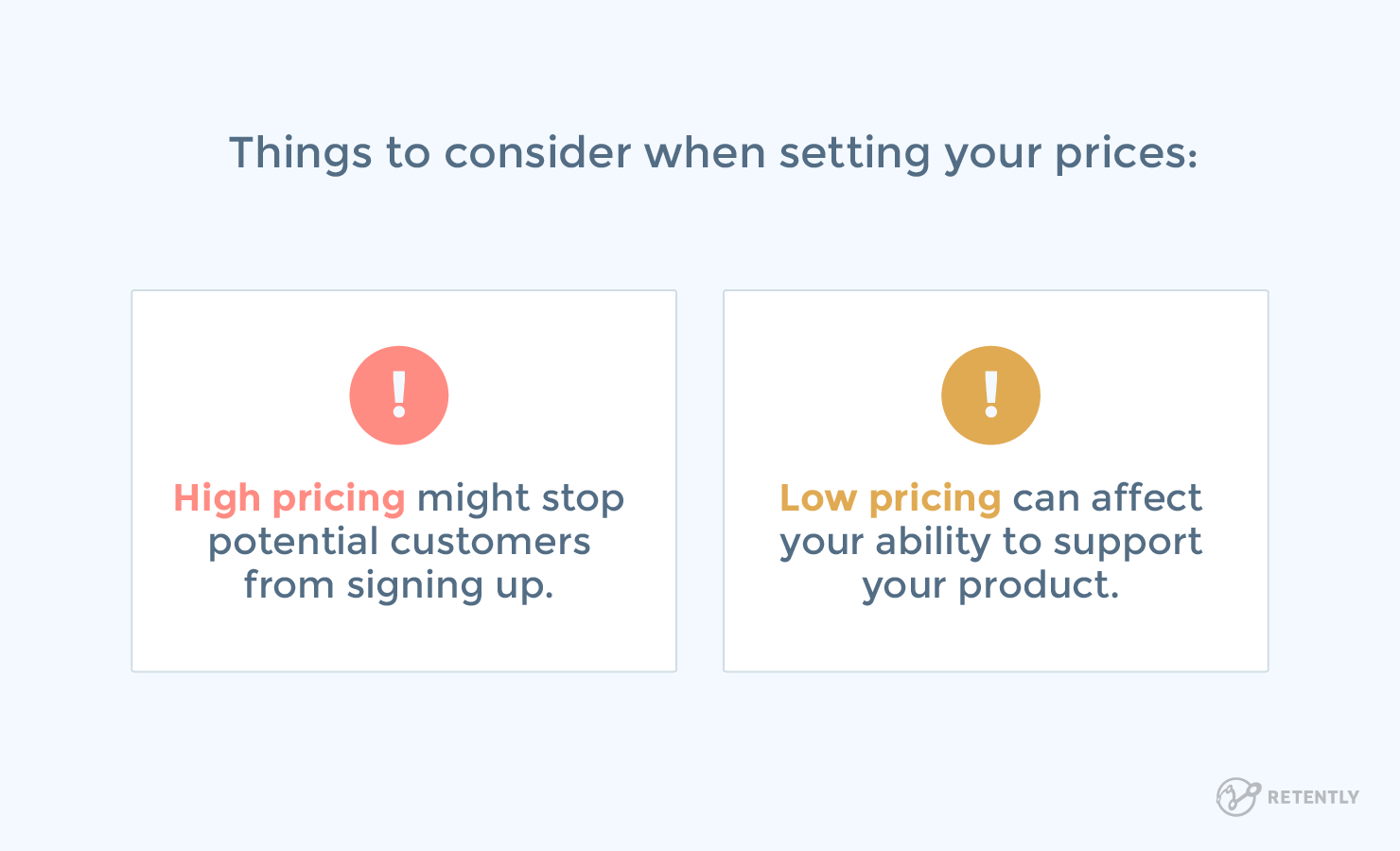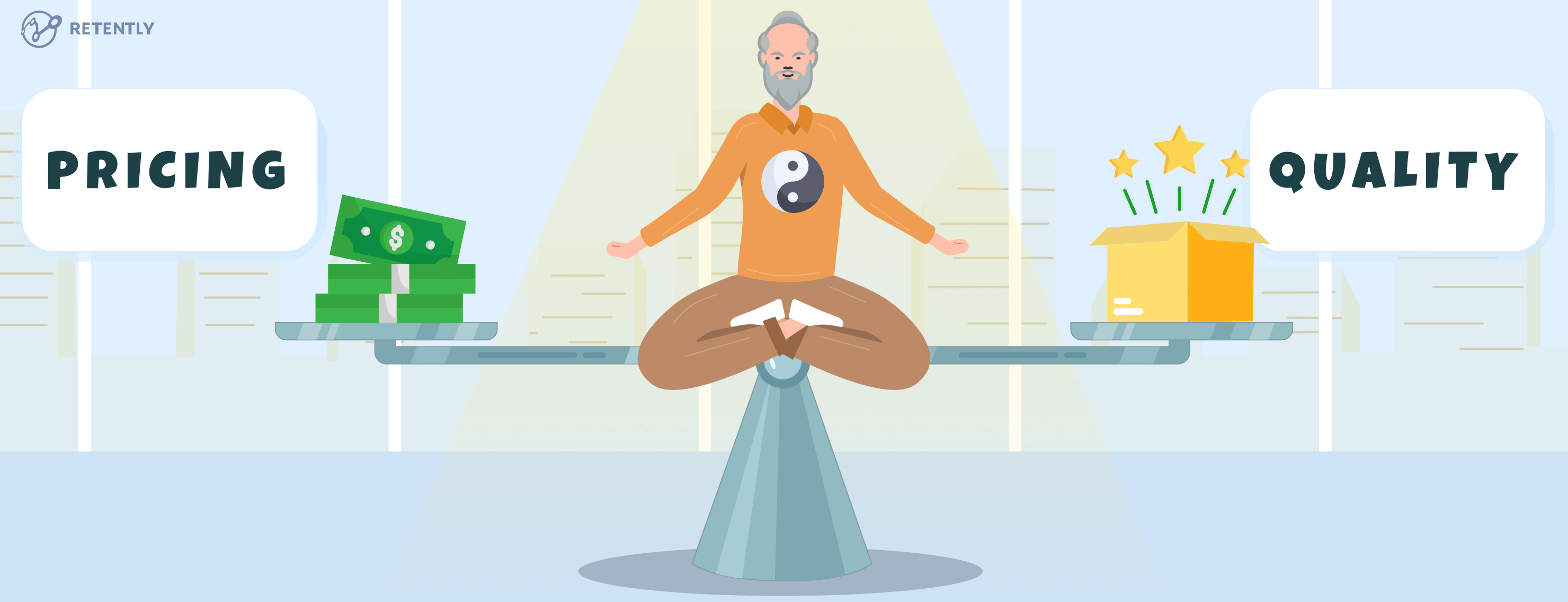Table of Contents
- Key Takeaways
- People Are Naturally Skeptical of the Cheapest Deal Around
- When You Change Your Pricing, You Change Your Audience
- In Some Markets, the Price Can Make a Product Desirable
- Customers Love Reasonable Prices, Not Necessarily Low Prices
- So What Makes a Price Feel Fair?
- Optimizing Pricing Strategies: Key Factors
- Is Your Pricing Helping or Hurting Retention?
Pricing strategy is one of the most important aspects of a business. In some ways, we are rational when it comes to making a purchase decision. In other ways, we aren’t. Placed next to each other, most people would select the more expensive product as the better one, even if it isn’t.
If two identical products were placed in front of each other – one priced at $49.99 and the other at $249.99 – which would you assume to be the best?
The pricing strategy of offering a more expensive product than competitors is often referred to as price-quality signaling. Setting a higher price than your competitors’ is meant to signal that your product is of better quality.
Luxury brands, from Swiss watch manufacturers to boutique fashion houses, have used this strategy very effectively for decades, earning a reputation for quality not just because of quality itself, but because of pricing that reflects it.
While the price of your product undeniably affects customer perception, does it also have an effect on satisfaction? Are customers more satisfied with your product if it costs more, and would raising your prices positively impact metrics like Net Promoter Score®?
As it turns out, it might. From freelance service providers to large companies, many businesses have reported a change in customer behavior and sentiment – almost always for the better – as their prices increased. Shortly, we’ll get into the “why”:
Key Takeaways
- Customers don’t just look at cost; they evaluate whether they’re getting fair value. A well-balanced price strengthens brand loyalty, while unclear or unfair pricing damages trust.
- The right pricing strategy depends on brand positioning and customer expectations. Whether a business uses cost-based, value-based, competitive, or dynamic pricing, it must align with what customers perceive as reasonable.
- Premium pricing can increase satisfaction – if backed by real value. Customers associate higher prices with quality, but businesses must ensure they deliver an experience that justifies the cost.
- Customers don’t just buy products, they buy into a feeling. Pricing influences how people perceive quality, fairness, and value. Get it wrong, and even a “cheap” product can leave them unsatisfied.
- Optimizing pricing is an ongoing process. Continuously test, gather customer feedback and refine your pricing strategy to balance affordability, perceived value and long-term profitability.
Now, let’s get to the point.
People Are Naturally Skeptical of the Cheapest Deal Around
A low price doesn’t always mean eager customers. Consumers are often naturally skeptical of prices below the market average, believing that a deal that looks “too good to be true” usually isn’t.
When you price your product below the competition, there’s a risk that the customers you draw in will view it skeptically. They might be more aware of its faults than normal and more alert to potential shortcomings and issues.
This can affect customer sentiment and satisfaction. When customers start using your product with the belief that “because it’s a cheap product, it isn’t the best in its category”, it often translates into skepticism and a lack of enthusiasm. As a result, this cautious approach becomes obvious in their overall experience with the product.
When You Change Your Pricing, You Change Your Audience
Consultants, freelancers, and agencies around the world can attest to the fact that cheap prices all too often attract clients with unrealistic expectations. Likewise, products marketed for cheap, value-for-money pricing often attract buyers seeking a great deal at a low cost.
When your business depends on retention, price-focused customers can become a frustrating liability. If you ever need to raise your prices, you risk losing them as your product is no longer the best deal on the market.
Changing your pricing often also means changing your audience. For a SaaS business, it could mean transitioning from an audience of solopreneurs to an audience of small businesses. For a different type of business, it could mean transitioning from SMEs to enterprise customers.
Different audiences have different expectations. Your current audience might like your product, but are they the best match? Often, changing your pricing changes the customers you attract, making it easier for you to achieve positive sentiment and a higher Net Promoter Score.

In Some Markets, the Price Can Make a Product Desirable
Swiss watchmakers like Patek Philippe and Audemars Piguet have built profitable businesses not by offering value for money, but by offering luxury exclusivity at a high price.
If these companies reduced their prices, they most likely wouldn’t win customers – instead, there’s a real risk that they would lose the customers they’ve spent decades earning.
Products that don’t seem to follow the laws of financial gravity are called aspirational products – items that are desirable not just because they’re good, but because they’re expensive. As these products become more expensive, the desire for them increases.
But let’s look into a more relatable example. Apple implements a premium pricing strategy, positioning itself as a provider of high-quality, innovative products. Despite being priced higher than competitors, the brand has built a loyal customer base that loves the unique experience and product value, paired with an exceptional service that justifies the price tag.
While the world of B2B and B2C software is very different from high fashion, there are several principles that apply to both industries:
- People want to buy something of high quality, and the price is often an indicator of quality.
- Management leaders often prioritize the “best” or most expensive solution over an unknown, less expensive one, even if it isn’t necessarily better.
- Many businesses are also guilty of irrational behavior when it comes to purchasing, prioritizing aspirational brands over brands that offer value for money.
The aspirational factor differs hugely between industries – few people buy a spreadsheet application because of its brand name. However, it still exists, and taking advantage of it through your pricing strategy can significantly affect customer satisfaction.
Customers Love Reasonable Prices, Not Necessarily Low Prices
A study by the Solvay Brussels School found that customers are more likely to develop a loyal, satisfied relationship with a business when products are priced reasonably.
The key term above is reasonable, not necessarily low or high. When pricing appears to be fair and in line with the product’s value, customers are more likely to develop a trusting, loyal commercial relationship.
Other studies, such as this study by Vinita Kaura, show that the perceived price has a significant positive impact on price fairness. When people believe prices are fair, they’re far more likely to form a positive opinion of the product, company, and brand.
If your product is underpriced – which means that it offers value far greater than its cost – your pricing strategy could be damaging both your profit margin and your ability to maximize satisfaction from customers who view its pricing as too good of a deal.
Low pricing can also affect your ability to support your product and its customers. If your weak profit margin makes it hard to offer good support or a generous return policy, for example, it’s likely to harm customer satisfaction.
So What Makes a Price Feel Fair?
A price is never just a number. It carries meaning and customers evaluate it based on:
- Transparency – Is the price clearly explained, or do hidden fees suddenly appear at checkout? (Nobody likes that!)
- Industry Norms – If a product is significantly more expensive than competitors’ without a clear reason, customers will question its fairness.
- Personal Expectations – A $10 burger at a fast-food place might feel expensive, but at a gourmet burger joint, it could feel like a steal.
When customers believe a price is fair, they’re more satisfied even if it’s higher than expected. But the moment they feel misled? That’s when frustration kicks in.
Why? Because pricing is about perception.
People don’t just pay for the product; they pay for the experience, the convenience, the brand reputation, and even how the price itself makes them feel.
- If something is too cheap, customers may assume it’s low quality.
- If something is too expensive, they may feel ripped off.
- But if the price aligns with their expectations, they’ll happily pay because it feels right.
Businesses that understand this can charge more without losing customer satisfaction as long as they justify the price with value.
Now let’s go through some strategies worth considering.
Optimizing Pricing Strategies: Key Factors
When customers consider buying a product, the price becomes critical to their decision-making. It sets the expectations for how good the product is and what value they’re getting – hence, for product value and quality. If the price matches what they think it’s worth, it can lead to a positive customer experience. Yet, dissatisfaction is inevitable if clients feel they are overpaying for the product.
Given the importance of product pricing in shaping customer satisfaction, it is essential to keep the following key takeaways in mind:
1. Market Research
First things first – make sure to do some thorough market research. Get a good grasp of the price range within your industry and how your prices compare to others. This will provide valuable insights into customer reference points and single out differentiation opportunities. Take a close look at market trends and try to understand customer preferences. Armed with this knowledge, you will be able to set prices that are appealing yet profitable. What’s more, competitive prices will help attract price-conscious customers while offering a sense of real value.
2. Perception of Value
Since customers judge a product’s value based on its price, you must ensure that your pricing aligns with what they think it’s worth. Moreover, you need to keep improving your offerings to meet customer expectations and exceed their initial perception. Clients are more likely to be satisfied when they feel they get a fair deal and that the price justifies the received benefits. Getting that balance right will inevitably increase your customer lifetime value.
3. Personalization
Consider offering various pricing options and perks to suit the preferences of different customer segments. For example, you could give loyal customers discounts when they renew subscriptions or offer them exclusive access to trial features. Creating subscription/product bundles or adding extra features can also provide customers with a more comprehensive solution. People like having choices, so presenting them with a range of pricing options will not only boost satisfaction but also appeal to a broader audience.
4. Communication
Communicate your product’s value clearly, no matter the price points. Help customers understand what they are paying for and why it is worth the investment. Transparency is key, so be upfront about your pricing structure and explain the reason for any price change. Keep things fair and avoid hidden costs or surprise charges that might upset customers. Efficient communication will help manage customer expectations and strengthen long-term relationships.
5. Customer Feedback
Always keep an eye on customer feedback and stay updated with the latest market trends. This way, you’ll stay responsive to customers’ evolving needs and adjust your pricing strategies accordingly. Pricing strategies should complement your overall customer-centric approach. Make it a habit to regularly gather feedback through NPS surveys or product reviews, and analyze customer data to address any concerns and make informed decisions. By actively listening to the voice of the customer, you can identify opportunities to refine pricing models and provide additional value.
Is Your Pricing Helping or Hurting Retention?
Pricing is one of the most challenging aspects of creating and selling a product. Set a too-high price and you risk alienating potential customers and force yourself to lower prices later in the process. Set a low price and you risk compromising your service and reducing your margin.
Companies use various pricing strategies to influence how customers perceive value:
- Cost-Based Pricing – Simple and transparent but may not align with customer expectations.
- Value-Based Pricing – Focuses on perceived worth, requiring deep customer insights.
- Competitive Pricing – Works in price-sensitive markets, but can harm profitability if overused.
- Dynamic Pricing – Adjusts with demand (e.g., airlines, ride-sharing), maximizes revenue but risks frustration if price changes feel unfair.
- Freemium & Subscriptions – Attracts users with free plans, but paid upgrades must feel worth it.
The bottom line? Pricing is one of the biggest trust signals for customers. It’s clear that pricing has a significant effect on customer satisfaction. Get it right – make it fair and reasonable – and your pricing will contribute to customer satisfaction instead of hurting it. Get it wrong, and you could end up upsetting or outright losing many of your customers.
Want to refine your pricing strategy? Start with your customers. Listen to their feedback, test different approaches, and always price with trust in mind.
From pricing to service, features and overall experience, Retently lets you survey customers to find out what they think about your product. Implement Net Promoter Score in your business and start collecting actionable feedback.



































 Greg Raileanu
Greg Raileanu 

 Christina Sol
Christina Sol 


